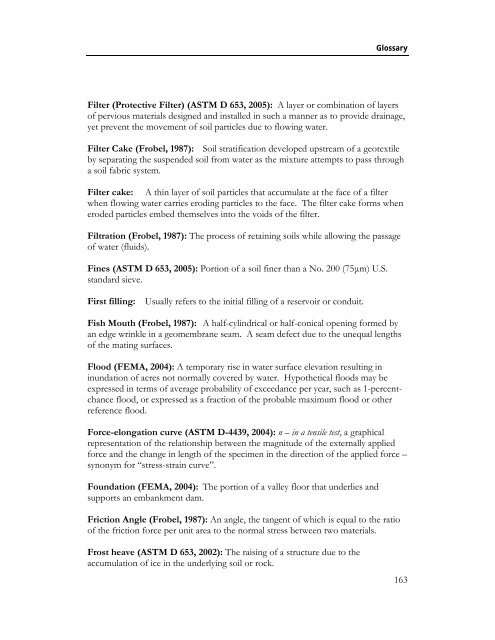Geotextiles in Embankment Dams - Association of State Dam Safety ...
Geotextiles in Embankment Dams - Association of State Dam Safety ...
Geotextiles in Embankment Dams - Association of State Dam Safety ...
Create successful ePaper yourself
Turn your PDF publications into a flip-book with our unique Google optimized e-Paper software.
GlossaryFilter (Protective Filter) (ASTM D 653, 2005): A layer or comb<strong>in</strong>ation <strong>of</strong> layers<strong>of</strong> pervious materials designed and <strong>in</strong>stalled <strong>in</strong> such a manner as to provide dra<strong>in</strong>age,yet prevent the movement <strong>of</strong> soil particles due to flow<strong>in</strong>g water.Filter Cake (Frobel, 1987): Soil stratification developed upstream <strong>of</strong> a geotextileby separat<strong>in</strong>g the suspended soil from water as the mixture attempts to pass througha soil fabric system.Filter cake: A th<strong>in</strong> layer <strong>of</strong> soil particles that accumulate at the face <strong>of</strong> a filterwhen flow<strong>in</strong>g water carries erod<strong>in</strong>g particles to the face. The filter cake forms wheneroded particles embed themselves <strong>in</strong>to the voids <strong>of</strong> the filter.Filtration (Frobel, 1987): The process <strong>of</strong> reta<strong>in</strong><strong>in</strong>g soils while allow<strong>in</strong>g the passage<strong>of</strong> water (fluids).F<strong>in</strong>es (ASTM D 653, 2005): Portion <strong>of</strong> a soil f<strong>in</strong>er than a No. 200 (75μm) U.S.standard sieve.First fill<strong>in</strong>g: Usually refers to the <strong>in</strong>itial fill<strong>in</strong>g <strong>of</strong> a reservoir or conduit.Fish Mouth (Frobel, 1987): A half-cyl<strong>in</strong>drical or half-conical open<strong>in</strong>g formed byan edge wr<strong>in</strong>kle <strong>in</strong> a geomembrane seam. A seam defect due to the unequal lengths<strong>of</strong> the mat<strong>in</strong>g surfaces.Flood (FEMA, 2004): A temporary rise <strong>in</strong> water surface elevation result<strong>in</strong>g <strong>in</strong><strong>in</strong>undation <strong>of</strong> acres not normally covered by water. Hypothetical floods may beexpressed <strong>in</strong> terms <strong>of</strong> average probability <strong>of</strong> exceedance per year, such as 1-percentchanceflood, or expressed as a fraction <strong>of</strong> the probable maximum flood or otherreference flood.Force-elongation curve (ASTM D-4439, 2004): n – <strong>in</strong> a tensile test, a graphicalrepresentation <strong>of</strong> the relationship between the magnitude <strong>of</strong> the externally appliedforce and the change <strong>in</strong> length <strong>of</strong> the specimen <strong>in</strong> the direction <strong>of</strong> the applied force –synonym for “stress-stra<strong>in</strong> curve”.Foundation (FEMA, 2004): The portion <strong>of</strong> a valley floor that underlies andsupports an embankment dam.Friction Angle (Frobel, 1987): An angle, the tangent <strong>of</strong> which is equal to the ratio<strong>of</strong> the friction force per unit area to the normal stress between two materials.Frost heave (ASTM D 653, 2002): The rais<strong>in</strong>g <strong>of</strong> a structure due to theaccumulation <strong>of</strong> ice <strong>in</strong> the underly<strong>in</strong>g soil or rock.163
















